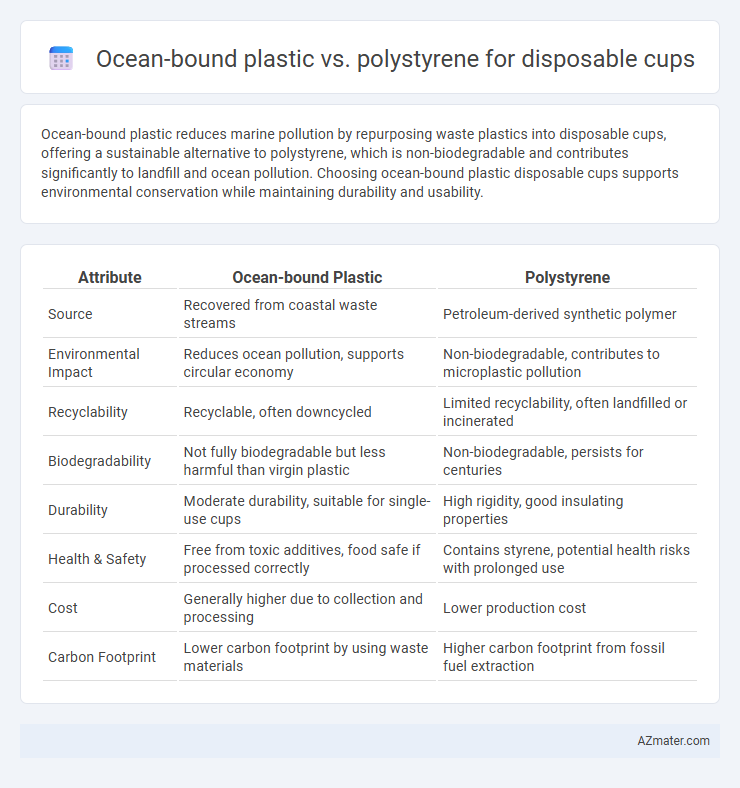Ocean-bound plastic reduces marine pollution by repurposing waste plastics into disposable cups, offering a sustainable alternative to polystyrene, which is non-biodegradable and contributes significantly to landfill and ocean pollution. Choosing ocean-bound plastic disposable cups supports environmental conservation while maintaining durability and usability.
Table of Comparison
| Attribute | Ocean-bound Plastic | Polystyrene |
|---|---|---|
| Source | Recovered from coastal waste streams | Petroleum-derived synthetic polymer |
| Environmental Impact | Reduces ocean pollution, supports circular economy | Non-biodegradable, contributes to microplastic pollution |
| Recyclability | Recyclable, often downcycled | Limited recyclability, often landfilled or incinerated |
| Biodegradability | Not fully biodegradable but less harmful than virgin plastic | Non-biodegradable, persists for centuries |
| Durability | Moderate durability, suitable for single-use cups | High rigidity, good insulating properties |
| Health & Safety | Free from toxic additives, food safe if processed correctly | Contains styrene, potential health risks with prolonged use |
| Cost | Generally higher due to collection and processing | Lower production cost |
| Carbon Footprint | Lower carbon footprint by using waste materials | Higher carbon footprint from fossil fuel extraction |
Introduction to Disposable Cup Materials
Disposable cups are commonly made from materials like ocean-bound plastic and polystyrene, each with distinct environmental impacts. Ocean-bound plastic refers to recycled plastic collected near coastlines, reducing marine pollution by repurposing waste into cup production. Polystyrene, a petroleum-based foam, is lightweight and insulating but poses significant challenges due to its non-biodegradability and low recycling rates, increasing landfill accumulation and environmental harm.
Understanding Ocean-Bound Plastic
Ocean-bound plastic refers to recyclable materials collected near coastlines that would otherwise pollute marine environments, significantly reducing ocean pollution when repurposed into disposable cups. Unlike polystyrene, a petroleum-based material notorious for its environmental persistence and difficulty in recycling, ocean-bound plastic offers a sustainable alternative by diverting waste from oceans and decreasing plastic pollution footprint. Utilizing ocean-bound plastic in disposable cup production supports circular economy efforts and minimizes harmful impacts on marine ecosystems compared to polystyrene cups.
What is Polystyrene?
Polystyrene is a synthetic aromatic polymer made from the monomer styrene, widely used in disposable cups due to its lightweight, insulating properties, and low cost. Ocean-bound plastic refers to waste collected near coastal areas before it enters the ocean, often repurposed into eco-friendly products, contrasting with polystyrene's non-biodegradable nature and environmental hazards. Unlike polystyrene, ocean-bound plastic supports sustainability efforts by reducing marine pollution and promoting circular economy practices.
Environmental Impact: Ocean-Bound Plastic vs Polystyrene
Ocean-bound plastic disposable cups significantly reduce marine pollution by repurposing waste that would otherwise enter oceans, lowering the environmental footprint compared to polystyrene cups known for their non-biodegradable nature and persistence in ecosystems. Polystyrene releases toxic compounds during degradation and is challenging to recycle, contributing to long-term soil and water contamination. Utilizing ocean-bound plastics promotes sustainable waste management, reducing microplastic formation and adverse effects on marine life.
Recycling and Waste Management Challenges
Ocean-bound plastic cups reduce plastic pollution by diverting waste from coastal areas, yet their recycling process is complicated due to contamination and mixed materials. Polystyrene (EPS) cups pose significant recycling challenges because of their low density and high contamination rates, making them less economically viable to process and often ending up in landfills. Effective waste management requires advanced sorting technologies and localized recycling programs tailored to handle material-specific obstacles for both ocean-bound plastics and polystyrene.
Health and Safety Considerations
Ocean-bound plastic disposable cups reduce environmental toxicity by repurposing waste while minimizing exposure to harmful chemicals commonly found in virgin polystyrene cups, such as styrene monomers linked to health risks. Polystyrene cups can leach hazardous substances, especially when used with hot beverages, posing potential carcinogenic and neurotoxic threats to consumers. Ocean-bound plastic alternatives prioritize safer consumption through recycled materials with lower chemical migration, aligning with health-conscious and eco-friendly safety standards.
Cost Comparison and Market Availability
Ocean-bound plastic disposable cups typically have a higher production cost than polystyrene cups due to the additional processing required to clean and recycle the collected marine debris. Polystyrene cups remain widely available and cost-effective in the market because of established manufacturing infrastructure and low raw material expenses. However, growing environmental regulations and consumer demand for sustainable alternatives are gradually increasing the market availability and competitive pricing of ocean-bound plastic cups.
Consumer Perceptions and Choices
Consumers increasingly favor ocean-bound plastic over polystyrene for disposable cups due to heightened environmental awareness and concerns about marine pollution. Ocean-bound plastic is perceived as a sustainable alternative that reduces plastic waste entering oceans, aligning with eco-friendly values sought by modern shoppers. Polystyrene cups, often criticized for their non-biodegradability and difficulty in recycling, face declining acceptance as consumers prioritize biodegradable and recyclable materials in their purchasing decisions.
Regulatory Policies and Industry Trends
Ocean-bound plastic is increasingly regulated by environmental policies such as the EU Single-Use Plastics Directive and California's SB 54, pushing manufacturers to adopt recycled materials in disposable cups. Polystyrene, often targeted by bans due to its non-recyclability and environmental persistence, faces stricter restrictions across numerous states and countries, influencing a decline in its usage. Industry trends show a strong shift toward sustainable, ocean-bound plastic alternatives driven by consumer demand, corporate responsibility goals, and evolving regulatory frameworks.
Future Outlook for Sustainable Disposable Cups
Ocean-bound plastic offers a promising future for sustainable disposable cups by significantly reducing marine pollution and utilizing recycled waste materials. Polystyrene, though lightweight and insulating, faces increasing regulatory restrictions and environmental concerns due to its non-biodegradable nature and limited recyclability. Innovations in biodegradable polymers and expanded use of ocean-bound plastic are expected to drive the development of eco-friendly disposable cups with a lower carbon footprint and improved waste management.

Infographic: Ocean-bound plastic vs Polystyrene for Disposable cup
 azmater.com
azmater.com